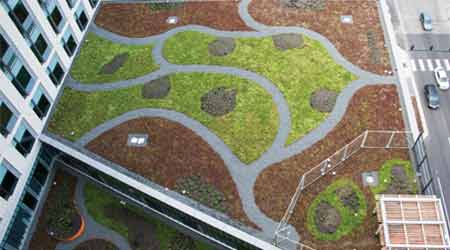As it becomes more important to make both new and existing buildings more sustainable, building owners are creating new ecological spaces for urban areas by installing green roofs instead of traditional ones, according to an article from Building Operating Management on the FacilitiesNet website.
Green roofs can incorporate several different elements to help the structure work more efficiently. For example, storm water detention tanks store rain overflow that is used in the building’s water system for irrigation and non-potable applications. Additional elements that can also be found on green roofs may include solar panels, wind turbines, and thermal heat exchangers. The solar panels and wind turbines are both used as sources of energy to reduce electricity consumption for the building. The thermal heat exchangers warm the water throughout the building.
Overall, green roofs provide range environmental, facility, corporate, and social benefits for both the environment and building owners and tenants. Benefits that make them worth considering include:
• Reducing urban heat island effect. When compared to traditional roofing, one of the biggest benefits of green roofs is their reduction of the urban heat island effect. This is due to the plants on the roofs either reflecting or absorbing heat and lowering the temperature around the building. The transpiration of the plants and evaporation of water also lower the overall temperature surrounding the building.
• Improving air quality. The foliage decreases dust in the air and removes pollutants from the atmosphere. The vegetation also absorbs carbon from the air, helping to mitigate climate change while further improving air quality by producing oxygen.

 UF Health Hospitals Rely on Green Globes to Realize Their Full Potential
UF Health Hospitals Rely on Green Globes to Realize Their Full Potential How Healthcare Facilities Can Be Truly Disaster-Resilient
How Healthcare Facilities Can Be Truly Disaster-Resilient TriasMD Breaks Ground on DISC Surgery Center for San Fernando Valley
TriasMD Breaks Ground on DISC Surgery Center for San Fernando Valley Bigfork Valley Hospital Falls Victim to Data Breach
Bigfork Valley Hospital Falls Victim to Data Breach AI-Driven Facilities: Strategic Planning and Cost Management
AI-Driven Facilities: Strategic Planning and Cost Management